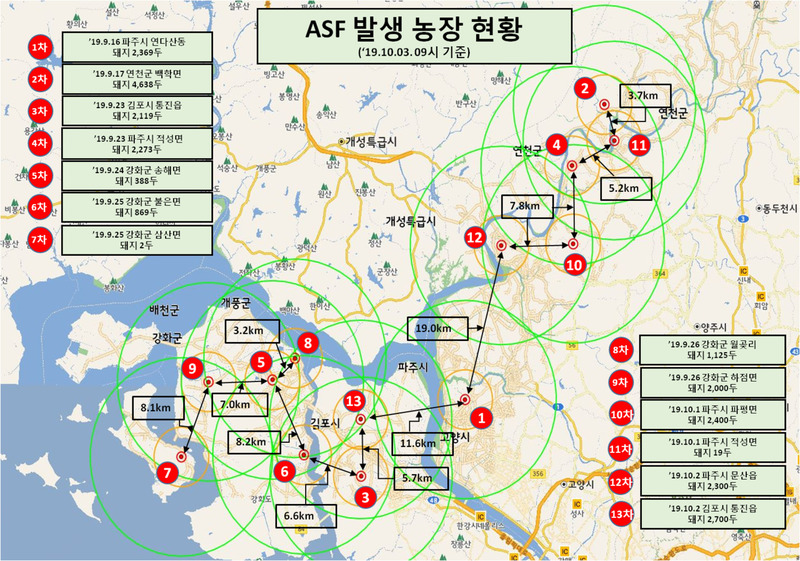 |
|
Quarantine authorities cull pigs at a farm in Paju, Gyeonggi Province, where African swine fever (ASF) has broken out on Oct. 2.
|
Discovery supports theory that virus transmitted by N. Korean boars
The African swine fever (ASF) virus has been detected for the first time in the carcass of a wild boar found in the demilitarized zone (DMZ). The discovery of infected boars in Incheon’s Gangwha County that presumably native to North Korea supports the theory that North Korean boars were the vector by which the virus was transmitted to South Korea. So far, the virus has turned up at 13 farms in South Korea. South Korea’s Ministry of Environment (ME) and the Ministry of National Defense (MND) announced on Oct. 3 that the ASF virus was detected in blood samples taken from the carcasses of wild boars found in the DMZ in Yeoncheon County, Gyeonggi Province, on Oct. 2. The samples were tested at the National Institute of Environmental Research. The wild boar carcasses were found by military units in the area and reported to the county, which then collected samples and sent them to the institute for testing. The MND explained that the dead boars were found at a point where the Southern Limit Line (SLL) on the DMZ is just 1.4km away from North Korea. “The movement of wild animals is blocked on the southern side of the DMZ by a barbed wire fence equipped with a high-tech warning system, but the barbed wire on the northern side of the DMZ isn’t as robust as ours and doesn’t appear to stop animals,” the MND said. This was the first time that wild boars in South Korea tested positive for ASF. The discovery of wild boars that presumably crossed over from North Korea in Gangwha County serves to support the theory that wild boars from North Korea were the vector by which the virus was transmitted. According to documents that the Incheon municipal authorities provided to Kim Hyeon-gwon, a lawmaker with the Democratic Party and a member of the National Assembly’s Agriculture, Food, Rural Affairs, Oceans, and Fisheries Committee, three wild boars were spotted on military surveillance cameras around 6 am on Sept. 17 on a sandbar inside the barbed ware fence on the coast of Gyodong Township, Gangwha County. Boars assumed to have swum across river to cross into S. Korea “These wild boars appear to have swum over from North Korea and then crossed back into the North. We’ve learned that this is an area where the water allows wild boars to cross the border. There needs to be more careful management of the water systems around the Han River and the Imjin River,” Kim said. The number of pig farms where ASF has been detected has increased to a total of 13. The Ministry for Agriculture, Food, and Rural Affairs announced on Thursday that the disease had been confirmed to be present at one pig farm in Munsan Township, Paju, and one pig farm in Tongjin Township, Gimpo, both in Gyeonggi Province. The owner of the pig farm in Munsan Township, Paju, contacted the municipal authorities when four sows showed signs of poor appetite. Some 2,300 pigs are being raised at the farm, and there are no other farms within a radius of 3 km. The owner of the farm in Tongjin Township, got in touch with city officials in Gimpo after four of his finishing pigs died. Some 2,800 pigs are being raised at the farm; there are eight other farms within a 3km radius, with a total of 24,515 pigs being raised in the area.
 |
|
A map of areas where ASF has broken out in areas near the DMZ, such as Ganghwa County and Yeoncheon County and the cities of Gimpo, and Paju in Gyeonggi Province.
|







